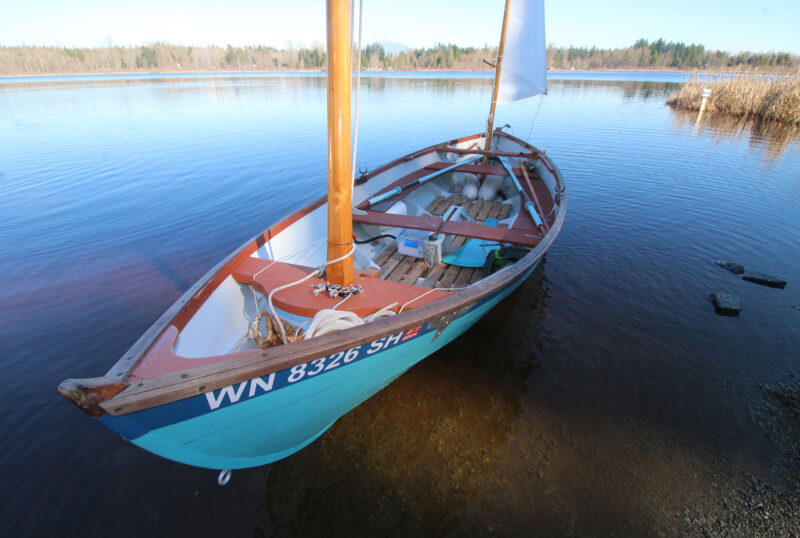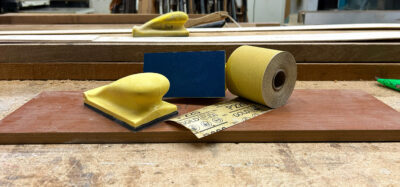In our March 2024 issue, we marked the passing of boat builder and designer Iain Oughtred. In the comments that followed my “From the Editor” column, several readers wrote about their experiences with Iain and the boats he’d designed. I took a special interest in this comment from Drew Britten: “You can add my BONNIE LASS to the number of Caledonia Yawls in the North Seattle area. I bought her in 2022 from a Camano Island man who bought her from Seattle’s Center for Wooden Boats (CWB) in 2014.” It’s the very Caledonia Yawl that I had written about in the March issue and which inspired me to build my own 19 years ago.
 Courtesy of Peter Mumford
Courtesy of Peter MumfordWhen Peter Mumford sailed ERIKA, her mainsail was a standing lug. It was later replaced with a balance lug and the Caledonia Yawls that followed also carried a balance-lug main, which had a boom that increased the spread of the sail for better performance off the wind.
After Drew bought the old double-ender, he got in touch with Iain and learned that it was the first Caledonia Yawl ever built. It also marked an important point in Iain’s career. In Iain Oughtred: A Life in Wooden Boats, author Nic Compton writes: “With so many designs available for amateur construction nowadays, it’s easy to forget what a landmark the Caledonia Yawl was.” And while it did not come early in Iain’s work as a designer, trailing his first design by 21 years, “…the Caledonia Yawl and the range of double-enders which followed soon came to be associated with Iain more than any other design of his.”
 Courtesy of Peter Mumford
Courtesy of Peter MumfordPeter discussed the tiller options with Iain and opted for the simplicity of a standard tiller albeit made short to swing behind the mizzen mast. It required sitting well aft to take the helm.
Iain, in response to Drew’s email, wrote to him in May 2022: “Glad you’ve got yourself such a fine boat! The design was first drawn up in 1988, after the prototype, ERIKA, was done for a friend (became a friend), Peter Mumford in PA (moved to the Pacific Northwest).” After a year of research, Drew was able to track down Peter, who had named the boat ERIKA after his mother, and wrote to him with a few photos attached. Peter replied: “That certainly does look like ERIKA to me. What a lovely boat. She was built in 1988 from Iain’s plans in Bruynzeel mahogany plywood. I’d be happy to know she’s still sailing. I started corresponding with Iain in the early 1980s. I still have his beautiful letters.”
 Joe Donahue
Joe DonahueJoe Donahue, the third owner of ERIKA, took this photo after launching at a boat ramp on the north end of Camano Island in September 2014. While she has her original sails here, Joe would eventually sew a new set for her.
Peter continued: “I was volunteering at the Apprenticeshop in Rockport, Maine, one summer, and they had a commission to build a lovely Shetland Island Sixern out of cedar planks. Iain and I discussed this and he loved the type, and thought a smaller plywood version would make a nice dayboat. So, that was when I asked Iain to draw ERIKA. My dad was paying for most of the project because he thought it was interesting. Iain and I discussed rigging her with a mizzen and balanced lug. These ideas partly came from Phil Bolger and partly from a chapter of Sail and Oar by John Leather, which includes a passage by Herbert Warington Smyth about the wisdom of a mizzen for exploring by dinghy: ‘The small West Country mizzen is somewhat of a nuisance to many sailors, but to anyone accustomed to it, its conveniences are innumerable. It is often of great assistance to the oars and with its aid I have worked to windward with a weather oar miles to windward in a lump of southwesterly sea that no boat of such size could have faced under sail. It is very useful for sail balance when the boat is loaded by the stern and it is easily taken in by a pull at the topping lift. It is the most tactful kind of sail because it is always there handy and yet is quite out of the way.’”
 Drew Britten
Drew BrittenAfter Drew Britten got the boat home, he raised the sails that Joe Donahue had sewn, with the main now a balance lug. The unpainted metal plates aft of the registration number, probably installed during the time at The Center for Wooden Boats, may have been added to reinforce the mast-partner fastenings.
“I wish I could say I built ERIKA,” Peter continued, “but I didn’t have the carpentry skills. In one of Phil Bolger’s books, he mentioned boatbuilder Ernie Tarr of Gloucester, so I looked him up and he built the boat. When she was completed, I sailed her out of Tenants Harbor, Maine. I did have trouble with the lack of detail in the plans at the time regarding the interior. Iain had not yet designed the interior, and it took me a while to make good seats. I did not have longitudinal benches, just thwarts. In Seattle, I sailed her across Puget Sound for a few years. She had a graceful way of slipping over and through waves, while heeled a bit. She was a lot of fun to sail in a bit of a breeze with one reef. I thought of her like a lively pony bounding along through fields. I ended up donating ERIKA to the CWB.”
The boat stayed at CWB for 20 years and was part of the livery fleet. CWB’s founder and elder statesman, Dick Wagner, passed away in 2017, and the origin of the boat was lost. After years of service as a rental, ERIKA was eventually put in storage, rather worse for the wear. In 2014, she was sold to Joe Donahue of Camano Island some 35 miles north northwest of Seattle.
 Drew Britten
Drew BrittenWhen Drew Britten acquired ERIKA, she was 35 years old and in need of attention. Many of the structural elements, like the floor timbers and the battens running along the middles of the garboards carried over to the finished plans for the Caledonia Yawl, but the full-length risers at the bottom of the sheerstrake and the partial frames attached to the floor timbers did not.
ERIKA had been out of the water for years and leaked around the centerboard trunk when Joe first launched her. She nearly sank when he left her at his dock overnight. Joe hauled her out to work on her and using only hand tools he built a new trunk, which stopped the leak. He also sewed a new set of sails and rebuilt the mainmast to make it taller and better fit the new lug main. With the boat seaworthy again, Joe used the Caledonia for crabbing and did a few cruises with a couple of friends from Camano to Whidbey Island, which lies a few miles west. After a few years with ERIKA, Joe moved on to a different boat, but he was reluctant to part with ERIKA. She spent five idle years in his driveway under a deteriorating cover.
 Christopher Cunningham
Christopher CunninghamDrew Britten, here rowing on northwest Washington’s Lake Cassidy, with Mount Pilchuck in the distance, is the current owner of ERIKA, now BONNIE LASS. While he’s an oarsman with a local racing crew, this Oughtred beach boat is the introduction to fixed-seat rowing and small-boat sailing for him and his family of four.
Joe sold ERIKA to Drew Britten. “In spring 2022,” Drew writes, “I became the most recent caretaker of this Caledonia Yawl and christened her BONNIE LASS, in honor of my Scottish-Irish heritage and my late mother, Bonnie. I was a huge fan of the Caledonia Yawl design and was saving money to buy a kit and build my own. However, I was delighted to find an already completed one for sale by Joe Donahue of Camano Island. It was over 30 years old and showing its age, but I was looking for a project boat. Joe was offering the Caledonia Yawl at a fair price, so I brought her home and have been working on the boat’s restoration ever since. When I bought the boat from Joe, all he knew of her history was that she was built in the 1980s. As an avid history lover, I looked into the boat’s origins as I worked on making her seaworthy. After a year of research, including correspondence with the designer and becoming a volunteer at CWB, I tracked down her original owner and uncovered her amazing story.”
 Christopher Cunningham
Christopher CunninghamDrew’s work on the boat has put her back to rights and, as BONNIE LASS, she has much to offer to her new family in the years, if not decades, to come.
Iain must have been pleased to learn that the prototype of his Caledonia Yawl was not forgotten or lost but in good hands with Drew, who writes “I am honored to have uncovered her history and honored to have been entrusted with her care.”![]()













In addition to being the first hull of the design, and therefore of historical interest, the boat is also a testament to the potential longevity of glued-plywood small-boat hulls. I often hear criticism of this construction type – that it won’t last – but this boat shows that with a modest amount of maintenance, such hulls can have a long life under sometimes hard service.
I couldn’t agree more, Alex. At 35+ years since her launch, the hull is remarkably sound. And that’s with 20 of those years in the CWB rental fleet, where she got much more abuse than a personal boat would, and most of their boats are tied to the dock without a cover, where they instead rely on volunteers to pump rainwater from the bilges after a shower.
Looking at rig, design and solutions of connecting thwarts and beams at this Caledonia Yawl makes the development of boat design very visible during the years. If one would look at Iain’s actual boat plans you could find very nicely defined pieces of wood that support thwarts and connect them to the hull. Beams are reduced to the height of the floorboards and (centre) thwarts would be in one piece to reinforce the hulls overall stability. Boatbuilders would possibly add buoyancy by closed compartments under the longitudinal seats or fore and aft, what Iain later implemented as a variation in his plans. This very first boat and the boatbuilder’s way to implement all structural parts wonderfully shows the very beginning of all these steps. For my own work designing a plywood boat from a traditionally built working boat means carefully taking care of the Boat types often regionally artisan-crafted parts and building techniques, translating them into modern boatbuilding – Iain Oughtred was a master in doing that. At the same time the mizzen mast and the type of rig shows that being open to new deas adds value for handling a small boat and create a successful design. Thanks for sharing the beginning.
Can you make a lazy jack for a lug rig? If so, how?
The Caledonia grabbed me a while back. The video series how to build her at Off Center Harbor reply fired my desire to build/have one. “Some day” as my 58′ requires all my attention for now..:-)